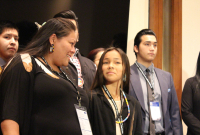Support strong Canadian climate journalism for 2025
Spending on clean drinking water, health, training and jobs are part of $3.4 billion in new investments planned by the Trudeau government over the next five years, as it strives to reconcile with Canada’s Indigenous people.
Budget documents tabled Wednesday by Finance Minister Bill Morneau bring the federal government’s total investment in First Nations, Inuit, and Métis communities to $11.8 billion over six years — an unprecedented investment for one of Canada’s youngest, and fast-growing populations.
The new money is part of the government’s efforts to meet 94 calls to action from the Truth and Reconciliation Commission — a panel that investigated how Canada mistreated its First Nations by removing them from communities and forcing them into residential schools where many were subject to horrible abuse and efforts to strip away their cultural identity. The residential school system was created in the 19th century and lasted until the 1990s before it was abolished.
While in opposition, the Prime Minister Justin Trudeau’s Liberals pledged to implement all 94 recommendations from the commission, but now in government, they have started to back away from some of those promises, including a pledge to be more transparent about how government policies and decisions could impact Indigenous rights and treaties.
The budget, currently awaiting approval from Parliament, has a strong focus on improving health outcomes for Indigenous people with a proposed additional investment of $204.2 million in mental health support systems over five years. It includes, for the first time, funding to make the mental health services of traditional healers available to First Nations and Inuit communities, and funding that will help expectant mothers travelling outside of their communities to bring a partner with them, rather than travelling alone when they are expecting to give birth.
Strong focus on improving mental health outcomes
The government says it’s a stark contrast from the spending habits of the previous government, which limited its expenditures above and beyond the two per cent funding cap for core Indigenous programming.
“We know that strong partnerships between the federal government and Indigenous communities are crucial for our success,” said Morneau in the House of Commons after tabling his budget on Wednesday. “Together, we will build stronger, more resilient communities and renew our nation-to-nation relationship with First Nations, Inuit and Métis.”
If approved, the cash brings the total investment in Indigenous health services to $828.2 million over five years. Funds will be divvied up into seven categories:
- Combatting chronic and infectious diseases ($50.2 million)
- Maternal and child health ($83.2 million)
- Primary care ($72.1 million)
- Mental wellness ($118.2 million)
- Home and palliative care ($184.6 million)
- Harm reduction ($15 million)
- Non-Insured Health Benefits Program ($305 million)

Support for post-secondary education
Budget 2017 also builds on 2016’s focus on strengthening Indigenous education through kindergarten to Grade 12, with a portfolio of investments in post-secondary education.
The government has promised to undertake a comprehensive review with Indigenous partners of all federal programs supporting indigenous students pursuing university and college studies, as it aims to provide $40 million to more than 12,000 indigenous students over five years.
It includes $89 million over three years to support Indigenous languages, restoration, and culture, $50 million in 2017-2018 for the Aboriginal Skills and Employment Training Strategy, and $14.7 million over three years to enhance the Northern Adult Basic Education Program.
Notably absent, however, is a plan to close the gap between the quality of care for Indigenous and non-Indigenous children — an omission to which Morneau responded:
“What we've done in this budget is make significant investments that are going to make a difference. Obviously there is much work to be done. Investments in health care on reserve are critically important. We recognize that we need to continue…”
Housing and infrastructure
While the government announced its largest investments in housing and community infrastructure in the budget last year, Budget 2017 proposes to spend $4 billion over 10 years to improve housing, clean water access, health facilities and community infrastructure beginning in the 2018 fiscal year.
According to federal officials, the government is on track to eliminate all drinking water advisories (DWAs) in indigenous communities by March 2021, and 60 per cent of long-term DWAs within three years. Since taking office in October 2015, 18 long-term DWAs have been eliminated.
New spending also includes $225 million over 11 years in financial support to housing providers serving Indigenous people off reserve. All funding, Finance Canada has noted, will be allocated and determined in partnership with Indigenous people, and the budget includes $3.1 million over three years to establish a secretariat that will support the Working Group on the Review of Laws and Policies related to Indigenous Peoples.






Comments
I needn't have read past the first paragraph, "Spending on clean drinking water, health, training and jobs are part of $3.4 billion in new investments planned by the Trudeau government over the next three years, as it strives to reconcile with Canada’s indigenous people" in order to understand that the "good times" and "reconciliation" planned for indigenes is going to be pushed back BEYOND THE NEXT FED ELECTION!
Had that paragraph stated 6.8 BILLION within the next TWO years I would have been able to read the rest of the article with a greater degree of acceptance. At least then we could hold this government to account for their failures on promises to aboriginal people in the electing of another government. Lord knows with all Trudeau's pronouncements to date regarding treaty rights and reconciliation (Kinder Morgan, Line 3, Trans- Canada, LNG in B.C., continued subsidies for fossil fuels, lack of subsidies for renewable development, ad infinitum) I can't put any faith in their insipid declaration to honor any promises beyond the extent of their present mandate. Words, words, words! We'll be listening to the same words as campaign promises preceding the nest fed alection. No way, m'lad are you getting another vote from me!